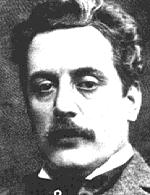

GIACOMO PUCCINI
22th December 1858 --- 29th November 1924
Copyright 1994-1998 Encyclopaedia Britannica
Last Updated on May 2025
By Steven Ritchie
And now for the Music

(3461)"The Girl of the Golden Wheel Selection". Sequenced by R.Steven Ritchie.
(3449)"Selection from Tosca". Sequenced by R.Steven Ritchie.
"Piano excerpts from La Boheme". Sequenced by R.Steven Ritchie.
(2536)"Piano excerpts from Madam Butterfly". Sequenced by R.Steven Ritchie.
Thanks to George Pollen for the music below.
NEW (4683)"Title Unknown. Sequenced by George Pollen.. (1429)"Senza Mamma from the opera Sister Angelica". Sequenced by George Pollen. Thanks to Ramon Pajares Box for the music below. Email (rpajares@rpajares.net)
"Tosca, opera, act 3, orchestral selection". Sequenced by Ramon Pajares Box.
(2536)"Orchestral excerpts from the 3rd act of the opera Tosca". Sequenced by Ramon Pajares Box.
"La Boheme, Musetta,Quando me'n vo, Lento, Mov.1". Sequenced by Bill King.
"La Boheme, Andantino, Mov.2". Sequenced by Bill King.
(1409)"Alcindoro". Sequenced by Bill King (1410)"My tiny hand is frozen". Sequenced by Bill King (2150)"Various Scenes from La Boheme". Sequenced by Maurizio Salvi. (2149)"Various Scenes from La Boheme". Sequenced by Maurizio Salvi. (254)"Various Scenes from La Boheme". Sequenced by M.Salvi (580)"E Lucevan le Stelle" from the opera "Tosca". Sequenced by Paulo Norberg (581)"Vissi d'arte, vissi d'amore-da Tosca". Sequenced by Marco Milano (582)"Vecchia zimarra, senti-da 'La Boheme'. Sequenced by Marco Milano (2151)"Various Scenes from La Boheme" .Sequenced by Marco Milano. (1411)"Turandot, Mov.1". Sequencer Unknown (1412)"Turandot, Mov.2". Sequencer Unknown (1406)"Humming song". Sequencer Unknown (1407)"Manina". Sequencer Unknown (1408)"Nessun". Sequencer Unknown (155)"Various Scenes from La Boheme,(Info by Ed)". Sequencer Unknown

If you done any Classical pieces of say for example, Delius, mozart, and so on etc,
please email them to the classical music site with details to
"classical (@) ntlworld.com" written this way to stop spammers
just remove spaces and brackets for email address, thank you.

Visitors to this page --

Back to Classical Midi Main Menu click "HERE"